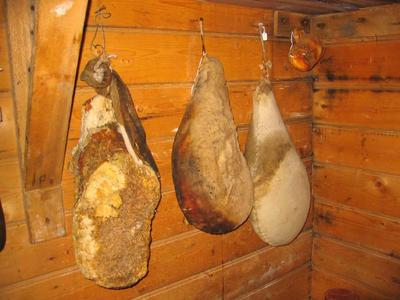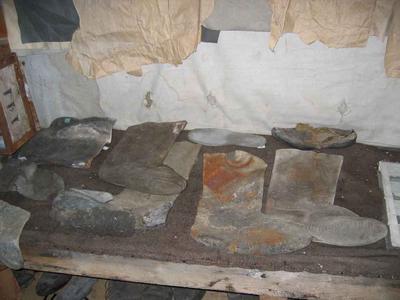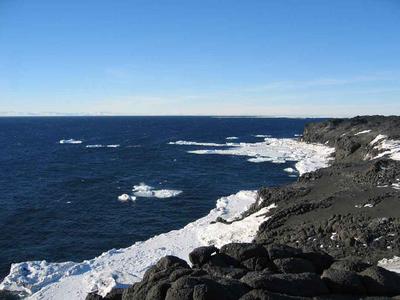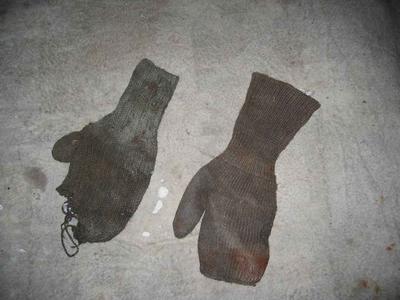7 December, 2003
Today we completed our 8th, and final, census for the season.
Today's count was approximately 800 seals, fewer than any of the last
few censuses. During this census there were far fewer mother/pup
pairs lounging about together on the ice. A majority of the pups
have been weaned and are on their own as their mothers return to the
ocean. Pup mortality is high for the first years of their life as
they learn how to survive on their own. It will be interesting to see
when and how many of those pups reappear in the study area over the
next few years.
In the evening we visited Cape Royds, site of both an Adelie Penguin
colony and a hut that was built by Ernest Shackleton and his crew of
the Nimrod on their 1907 expedition. It had been almost a month
since our last trip to Cape Royds, and things have changed out there.
The area where we parked our snowmobiles last month is now open
water. The ice edge moved about 2km closer during last week's storm,
leaving much of Cape Royds with true 'beachfront property'.
Shackleton's 1907 expedition on the Nimrod was his second trip to
Antarctica. He had been a part of Scott's Discovery Expedition of
1902 and this time returned leading his own group of men. He had
promised Scott that he wouldn't land in McMurdo Sound, but was forced
to break that promise when he encountered thick ice that blocked any
other alternative harbors. They landed at Cape Royds in late
January, and sent their ship back to New Zealand on February 22nd
with instructions to return before March of 1908. The men built
their hut and settled in for the winter.
On October 29th they left the relative comfort of their hut and set
off for the South Pole, using a combination of ponies, dogs, and men
to haul the heavy sleds. The ponies were unsuited to Antarctic
travel and succumbed early on in the expedition. In early January
the men reached 880 23' S, 97 miles from the South Pole, before
dwindling supplies forced them to turn around. This was 360 miles
further south than Scott had gotten in his Discovery expedition.
When they left, Shackleton had instructed the men left at Cape Royds
to sail on March 1st (the Nimrod was scheduled to return for them in
late February). He felt that, if they had not returned by that date,
the rest of the group should assume that they had died in their
attempt. The men, sick with dysentery and suffering from a lack of
adequate food and water, made it to Hut Point just as a small group
of men set forth to look for their bodies prior to leaving on the
Nimrod.
Although they did not reach the geographic South Pole, a group of
three men from the expedition made it to the magnetic South Pole.
They were the first to reach that point. In addition, members of the
party climbed Mt. Erebus, marking the first ascent of a peak in
Antarctica. The trip to the top took five days, while their return
trip took only 1 1/2.
The hut, like Scott's at Cape Evans, has been restored with much of
the original furnishings and supplies. The sleeping bags are on some
of the bunks, while food and kitchen supplies line the shelves.
Visiting the hut can give only a small glimpse into what life on the
ice was like almost 100years ago.
Daily Haiku:
Nimrod explorers
Setting off for the South Pole
Furthest south of all

This is the hut at Cape Royds that was built and used by Shackleton and his men of the Nimrod expedition.

It took us a while to figure out what these three objects were hanging on the rear wall of the hut. In case you can't guess--these are some leftover hams.

Boots used on the expedition.

This is the view that greeted the men as they looked out the door towards the ocean.

The expedition used sleeping bags made of reindeer hide that they purchased in Norway.

It was amazing to see the open water. Last time we visited Cape Royds we parked our snowmobiles on the ice that was once there.

Here are some rather threadworn mittens left from the expedition.
Contact the TEA in the field at
.
If you cannot connect through your browser, copy the
TEA's e-mail address in the "To:" line of
your favorite e-mail package.
|
